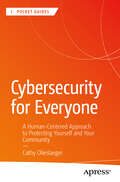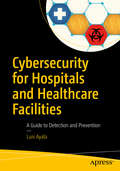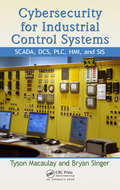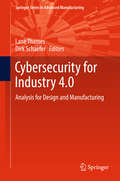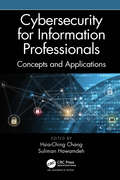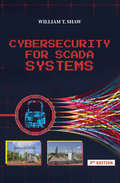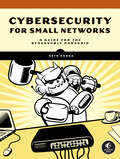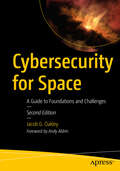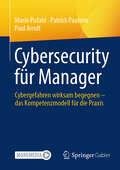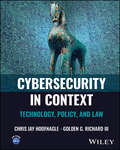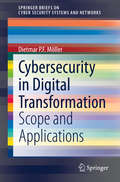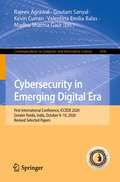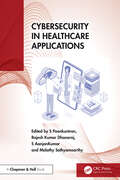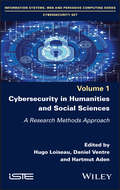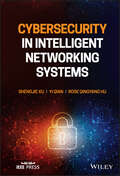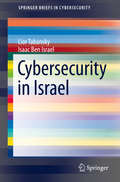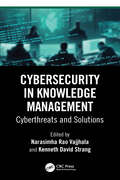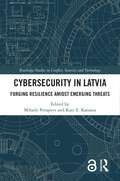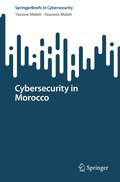- Table View
- List View
Cybersecurity for Everyone
by David B. SkillicornCyberspace is a critical part of our lives. Although we all use cyberspace for work, entertainment, and social life, much of its infrastructure and operation is invisible to us. We spend a big part of our lives in an environment that is almost an essential service but is full of potential dangers: a place where criminals can commit new kinds of crimes, where governments can exert political pressure, and where we can be hurt by the unthinking actions of the bored and careless. Making cyberspace more secure is one of the challenges of our times. This is not only (or perhaps even primarily) a technical challenge. It requires actions by governments and businesses to encourage security whenever possible, and to make sure that their own actions do not undermine it. Unfortunately, many of those in a position to do something about cybersecurity do not have the background to understand the issues fully. Cybersecurity for Everyone will help by describing the issues in a way that is accessible to anyone, but especially those from non-technical backgrounds.
Cybersecurity for Everyone: A Human-Centered Approach to Protecting Yourself and Your Community (Apress Pocket Guides)
by Cathy OlieslaegerIn a world where cyber threats are growing exponentially in number and complexity, it&’s time to ask the tough question: What are we doing wrong? We&’ve been tackling cybersecurity the same way for years, yet the bad actors continue to stay ahead. Financial losses mount, and the talent gap in the cybersecurity industry remains a persistent challenge. It&’s time to break the cycle. This book takes a bold, fresh look at cybersecurity by shifting the focus away from the technical jargon and putting the spotlight on the people who matter most—you. Whether you&’re a student, a professional, a parent, or a business leader, this book is designed to help you understand cybersecurity&’s role in everyday life and how you can make a difference. From the classroom to the boardroom, there&’s a shared responsibility in keeping our digital world safe. Unlike traditional cybersecurity books filled with complex terminology and tech-heavy concepts, this book humanizes the topic. It provides practical, real-world solutions for protecting yourself, your family, your workplace, and your community. You&’ll learn not just the how but also the why—why cybersecurity matters and why it's a people-first issue that concerns all of us, regardless of our background or profession. Whether you&’re just starting your cybersecurity journey or you're looking to build a security-first culture within your organization, this book equips you with the knowledge and confidence to make an impact. With a focus on democratizing cybersecurity knowledge, this guide is your call to action, offering accessible insights to foster a more secure digital future for everyone. What You Will Learn Protect yourself and the people you care about Journey into cybersecurity without having to break anything Educate students about keeping safe in the digital world Build bridges between the educational and professional worlds Establish a cybersecurity cultrure as a bsiness leader Who This Book Is For Whether you&’re a student, professional, parent, or business leader, this book is designed to help you understand cybersecurity&’s role in everyday life and how you can make a difference. From the classroom to the boardroom, there&’s a shared responsibility in keeping our digital world safe.
Cybersecurity for Hospitals and Healthcare Facilities: A Guide to Detection and Prevention
by Luis AyalaLearn how to detect and prevent the hacking of medical equipment at hospitals and healthcare facilities. A cyber-physical attack on building equipment pales in comparison to the damage a determined hacker can do if he/she gains access to a medical-grade network as a medical-grade network controls the diagnostic, treatment, and life support equipment on which lives depend. News reports inform us how hackers strike hospitals with ransomware that prevents staff from accessing patient records or scheduling appointments. Unfortunately, medical equipment also can be hacked and shut down remotely as a form of extortion. Criminal hackers will not ask for a $500 payment to unlock an MRI, PET or CT scan, or X-ray machine--they will ask for much more. Litigation is bound to follow and the resulting punitive awards will drive up hospital insurance costs and healthcare costs in general. This will undoubtedly result in increased regulations for hospitals and higher costs for compliance. Unless hospitals and other healthcare facilities take the steps necessary to secure their medical-grade networks, they will be targeted for cyber-physical attack, possibly with life-threatening consequences. Cybersecurity for Hospitals and Healthcare Facilities is a wake-up call explaining what hackers can do, why hackers would target a hospital, the way hackers research a target, ways hackers can gain access to a medical-grade network (cyber-attack vectors), and ways hackers hope to monetize their cyber-attack. By understanding and detecting the threats, you can take action now--before your hospital becomes the next victim. What You Will Learn: Determine how vulnerable hospital and healthcare building equipment is to cyber-physical attack Identify possible ways hackers can hack hospital and healthcare facility equipment Recognize the cyber-attack vectors--or paths by which a hacker or cracker can gain access to a computer, a medical-grade network server, or expensive medical equipment in order to deliver a payload or malicious outcome Detect and prevent man-in-the-middle or denial-of-service cyber-attacks Detect and prevent hacking of the hospital database and hospital web application Who This Book Is For: Hospital administrators, healthcare professionals, hospital & healthcare facility engineers and building managers, hospital & healthcare facility IT professionals, and HIPAA professionals
Cybersecurity for Industrial Control Systems: SCADA, DCS, PLC, HMI, and SIS
by Tyson Macaulay Bryan L. SingerAs industrial control systems (ICS), including SCADA, DCS, and other process control networks, become Internet-facing, they expose crucial services to attack. Threats like Duqu, a sophisticated worm found in the wild that appeared to share portions of its code with the Stuxnet worm, emerge with increasing frequency. Explaining how to develop and im
Cybersecurity for Industry 4.0: Analysis for Design and Manufacturing (Springer Series in Advanced Manufacturing)
by Dirk Schaefer Lane ThamesThis book introduces readers to cybersecurity and its impact on the realization of the Industry 4. 0 vision. It covers the technological foundations of cybersecurity within the scope of the Industry 4. 0 landscape and details the existing cybersecurity threats faced by Industry 4. 0, as well as state-of-the-art solutions with regard to both academic research and practical implementations. Industry 4. 0 and its associated technologies, such as the Industrial Internet of Things and cloud-based design and manufacturing systems are examined, along with their disruptive innovations. Further, the book analyzes how these phenomena capitalize on the economies of scale provided by the Internet. The book offers a valuable resource for practicing engineers and decision makers in industry, as well as researchers in the design and manufacturing communities and all those interested in Industry 4. 0 and cybersecurity.
Cybersecurity for Information Professionals: Concepts and Applications
by Hsia-Ching ChangInformation professionals have been paying more attention and putting a greater focus on privacy over cybersecurity. However, the number of both cybersecurity and privacy breach incidents are soaring, which indicates that cybersecurity risks are high and growing. Utilizing cybersecurity awareness training in organizations has been an effective tool to promote a cybersecurity-conscious culture, making individuals more cybersecurity-conscious as well. However, it is unknown if employees’ security behavior at work can be extended to their security behavior at home and personal life. On the one hand, information professionals need to inherit their role as data and information gatekeepers to safeguard data and information assets. On the other hand, information professionals can aid in enabling effective information access and dissemination of cybersecurity knowledge to make users conscious about the cybersecurity and privacy risks that are often hidden in the cyber universe. Cybersecurity for Information Professionals: Concepts and Applications introduces fundamental concepts in cybersecurity and addresses some of the challenges faced by information professionals, librarians, archivists, record managers, students, and professionals in related disciplines. This book is written especially for educators preparing courses in information security, cybersecurity, and the integration of privacy and cybersecurity. The chapters contained in this book present multiple and diverse perspectives from professionals in the field of cybersecurity. They cover such topics as: Information governance and cybersecurity User privacy and security online and the role of information professionals Cybersecurity and social media Healthcare regulations, threats, and their impact on cybersecurity A socio-technical perspective on mobile cybersecurity Cybersecurity in the software development life cycle Data security and privacy Above all, the book addresses the ongoing challenges of cybersecurity. In particular, it explains how information professionals can contribute to long-term workforce development by designing and leading cybersecurity awareness campaigns or cybersecurity hygiene programs to change people’s security behavior.
Cybersecurity for Reconfigurable Hardware Based Critical Infrastructures
by Amlan Chakrabarti Jyoti Prakash Singh Krishnendu GuhaThe book commences with an introductory section on reconfigurable computing and thereafter delves into its applications in critical infrastructures. This book analyzes how such systems may be affected due to vulnerabilities and also discusses how these can be attacked by adversaries or cybercriminals. This book also discusses protection mechanisms related to such threats. It initially starts with an introduction to the various industrial revolutions and the changes in security needs, followed by a basic description of reconfigurable hardware based critical infrastructures. Further, the book contains discussion on security administration and planning, auditing, monitoring and analysis, risk-response and recovery, control and countermeasures highlighting their need in reconfigurable hardware-based platforms. In addition to these, new concepts are introduced such as AI/ML for cybersecurity, digital forensics related to reconfigurable hardware based critical infrastructures. Finally, a hands on learning experience is presented to provide the readers with a practical flavour. The book will be useful to students (graduate and undergraduate), researchers, academicians and industry professionals.
Cybersecurity for SCADA Systems
by William T. ShawThe world has changed since the first edition was published in 2006. There have been many technological changes in communications and networking and in other areas of computer science. More focus is given to implementing cybersecurity protections and technical countermeasures. The second edition also takes advantage of the evolved industry-specific cybersecurity standards that have emerged, especially in the electric power and oil-and-gas pipeline industry sectors. Cybersecurity for SCADA Systems, 2nd Edition is intended to provide a general background of SCADA system technology and cybersecurity concepts and technologies, showing how the two can be brought together to safeguard our infrastructure and computer automation systems. This book provides a high-level overview of this unique technology, with an explanation of each market segment. Readers will understand the vital issues and learn strategies for decreasing or eliminating system vulnerabilities. Cybersecurity for SCADA Systems, 2nd Edition is suitable for nontechnical, management-level personnel as well as IT personnel without SCADA experience. Features and Benefits Functional breakdown and explanation of the typical features, capabilities, and components of a SCADA system IT and cybersecurity technology and terminology overview and explanation Industry-specific as well as generalized discussion of SCADA vulnerabilities and available remediation strategies Discussion of physical and electronic security issues and strategies Audience IT personnel Management Students
Cybersecurity for Small Networks: A No-Nonsense Guide for the Reasonably Paranoid
by Seth EnokaA guide to implementing DIY security solutions and readily available technologies to protect home and small-office networks from attack.This book is an easy-to-follow series of tutorials that will lead readers through different facets of protecting household or small-business networks from cyber attacks. You&’ll learn how to use pfSense to build a firewall, lock down wireless, segment a network into protected zones, configure a VPN (virtual private network) to hide and encrypt network traffic and communications, set up proxies to speed up network performance and hide the source of traffic, block ads, install and configure an antivirus, back up your data securely, and even how to monitor your network for unauthorized activity and alert you to intrusion.
Cybersecurity for Smart Cities: Practices and Challenges (Advanced Sciences and Technologies for Security Applications)
by Mohiuddin Ahmed Paul Haskell-DowlandEnsuring cybersecurity for smart cities is crucial for a sustainable cyber ecosystem. Given the undeniable complexity of smart cities, fundamental issues such as device configurations and software updates should be addressed when it is most needed to fight cyber-crime and ensure data privacy. This book addresses the cybersecurity challenges associated with smart cities, aiming to provide a bigger picture of the concepts, intelligent techniques, practices and research directions in this area. Furthermore, this book serves as a single source of reference for acquiring knowledge on the technology, processes and people involved in the next-generation of cyber-smart cities.
Cybersecurity for Space: A Guide to Foundations and Challenges
by Jacob G. OakleySpace is one of the fastest growing military, government and industry sectors. Because everything in today’s world exists within or connected to cyberspace, there is a dire need to ensure cybersecurity is addressed in the burgeoning field of space operations. This revised and expanded edition will prime the reader with the knowledge needed to understand the unique challenges to space operations which affect the implementation of cybersecurity. Further, the reader will have foundational knowledge on what impacts cyber threats can have on space systems and how cybersecurity must rise to meet them. The author, who spent years in the United States Marine Corps, originally involved in satellite communications is now a seasoned cyber security practitioner who has provided cyber security vision and strategy to a large portfolio of systems and programs, many focused specifically in space. A published academic and experienced professional, he brings a practical, real-world and tempered approach to securing the final frontier. What You Will Learn Basic concepts of how different space vehicles operate in general. How such systems and their components integrate into cyberspace. A clear picture of the potential damage available via cyber-attacks to such systems. Basic efforts to mitigate such cyber threats will be presented through the various portions of space operations. Foundational issues at the intersection of the space and cyber domains Who This Book Is For This book is written for anyone curious about warfare in the era of cyber everything, those involved in cyber operations and cyber warfare, as well as security practitioners and policy or decision makers who are on the sending or receiving end of such activity.
Cybersecurity for Space: Protecting the Final Frontier
by Jacob G. OakleyThis is the first book of its kind to cover the unique challenges of creating, maintaining, and operating a system that operates in both outer space and cyber space. It covers the impact that cyber threats can have on space systems and how the cybersecurity industry must rise to meet the threats. Space is one of the fastest growing military, government, and industry sectors. Because everything in today’s world exists within or connected to cyberspace, there is a dire need to ensure that cybersecurity is addressed in the burgeoning field of space operations. You will be introduced to the basic concepts involved in operating space systems that include low earth orbit (LEO), geosynchronous orbit (GEO), and others. Using the related high-level constraints, threats, and vectors, you will be able to frame a clear picture of the need and challenges of bringing cybersecurity to bear on satellites, space vehicles, and their related systems. The author, who has spent seven years in the US Marine Corps and was originally involved in satellite communications and later cyber operations, is now a seasoned cybersecurity practitioner currently implementing cybersecurity vision and strategy to a large portfolio of systems and programs, many focused specifically in space. A published academic and experienced professional, he brings a practical, real-world and tempered approach to securing space vehicles and their systems. What You Will Learn Understand what constitutes a space system and the challenges unique to operations of all spacecraftGet introduced to various space vehicles and their unique constraints and challengesBe aware of the physical and cyber threats to the space vehicle and its ability to fly and orbitKnow the physical and cyber vectors from which threats may manifestStudy the micro- and macro-analysis provided of space system attack scenariosBe familiar with the high-level problems of cybersecurity in the space domain Who This Book Is For This book is written for two audiences: those with a background in space operations as well as those in cybersecurity. It offers the guidance needed to understand the unique challenges to space operations that affect the implementation of cybersecurity.
Cybersecurity für Manager: Cybergefahren wirksam begegnen – das Kompetenzmodell für die Praxis
by Mario Pufahl Patrick Paulsen Paul ArndtDieses Buch erklärt verständlich, was Cyber Security ist und wie Unternehmen der Bedrohungslage im Internet effektiv begegnen können. Entscheidungsträger erhalten leicht verständliche Denkanstöße und können sich anhand eines methodischen Rahmens Schritt für Schritt diesem zentralen Thema nähern und es besser durchdringen – die Voraussetzung, um gemeinsam mit IT- und Cyber-Security-Experten bessere operative Entscheidungen zu treffen. Die Bedeutung von Cyber Security nimmt von zu Tag Tag zu, da immer mehr Firmen gegen ihren Willen digital attackiert werden. Dies bringt das Thema auf den Tisch der Geschäftsführungen.In diesem Buch wird das Thema Cyber Security, das technisch sehr komplex und für IT-Laien schwer verständlich sein kann, auf eine verständliche Art und Weise dargestellt.
Cybersecurity in Context: Technology, Policy, and Law
by Chris Jay Hoofnagle Golden G. Richard III“A masterful guide to the interplay between cybersecurity and its societal, economic, and political impacts, equipping students with the critical thinking needed to navigate and influence security for our digital world.” —JOSIAH DYKSTRA, Trail of Bits “A comprehensive, multidisciplinary introduction to the technology and policy of cybersecurity. Start here if you are looking for an entry point to cyber.” —BRUCE SCHNEIER, author of A Hacker’s Mind: How the Powerful Bend Society’s Rules, and How to Bend Them Back The first-ever introduction to the full range of cybersecurity challenges Cybersecurity is crucial for preserving freedom in a connected world. Securing customer and business data, preventing election interference and the spread of disinformation, and understanding the vulnerabilities of key infrastructural systems are just a few of the areas in which cybersecurity professionals are indispensable. This textbook provides a comprehensive, student-oriented introduction to this capacious, interdisciplinary subject. Cybersecurity in Context covers both the policy and practical dimensions of the field. Beginning with an introduction to cybersecurity and its major challenges, it proceeds to discuss the key technologies which have brought cybersecurity to the fore, its theoretical and methodological frameworks and the legal and enforcement dimensions of the subject. The result is a cutting-edge guide to all key aspects of one of this century’s most important fields. Cybersecurity in Context is ideal for students in introductory cybersecurity classes, and for IT professionals looking to ground themselves in this essential field.
Cybersecurity in Digital Transformation: Scope and Applications (SpringerBriefs on Cyber Security Systems and Networks)
by Dietmar P.F. MöllerThis book brings together the essential methodologies required to understand the advancement of digital technologies into digital transformation, as well as to protect them against cyber threat vulnerabilities (in this context cybersecurity attack ontology is included, modeling different types of adversary knowledge). It covers such essential methodologies as CIA Triad, Security Risk, Likelihood, and Consequence Level, Threat Attack Profiling, Threat Intelligence, Threat Lifecycle and more. The idea behind digital transformation is to use digital technologies not only to replicate an existing process in a digital form, but to use digital technology to transform that process into something intelligent (where anything is connected with everything at any time and accessible and controlled and designed advanced). Against this background, cyber threat attacks become reality, using advanced digital technologies with their extreme interconnected capability which call for sophisticated cybersecurity protecting digital technologies of digital transformation.Scientists, advanced-level students and researchers working in computer science, electrical engineering and applied mathematics will find this book useful as a reference guide. Professionals working in the field of big data analytics or digital/intelligent manufacturing will also find this book to be a valuable tool.
Cybersecurity in Emerging Digital Era: First International Conference, ICCEDE 2020, Greater Noida, India, October 9-10, 2020, Revised Selected Papers (Communications in Computer and Information Science #1436)
by Valentina Emilia Balas Kevin Curran Rajeev Agrawal Goutam Sanyal Madhu Sharma GaurThis book constitutes selected and revised papers from the First International Conference on Cybersecurity in Emerging Digital Era, ICCEDE 2020, held in Greater Noida, India, in October 2020. Due to the COVID-19 pandemic the conference was held online. The 9 full papers and 2 short papers presented in this volume were thoroughly reviewed and selected from 193 submissions. The papers are organized in topical sections on cyber security issues and challenges in emerging digital era; security resilience in contemporary applications.
Cybersecurity in Germany (SpringerBriefs in Cybersecurity)
by Martin Schallbruch Isabel SkierkaIn 2016, Germany's government presented its third cybersecurity strategy, which aims to strengthen the national cyber defence architecture, cooperation between the state and industry, and individual users’ agency. For many years, Germany has followed/adopted a preventive and engineering approach to cybersecurity, which emphasizes technological control of security threats in cyberspace over political, diplomatic and military approaches. Accordingly, the technically oriented Federal Office for Information Security (BSI) has played a leading role in Germany’s national cybersecurity architecture. Only in 2016 did the military expand and reorganize its cyber defence capabilities. Moreover, cybersecurity is inextricably linked to data protection, which is particularly emphasised in Germany and has gained high public attention since Edward Snowden’s revelations. On the basis of official documents and their insights from many years of experience in cybersecurity policy, the two authors describe cyber security in Germany in the light of these German peculiarities. They explain the public perception of cybersecurity, its strong link with data protection in Germany, the evolution of Germany's cybersecurity strategies, and the current organisation of cybersecurity across the government and industry. The Brief takes stock of past developments and works out the present and future gaps and priorities in Germany’s cybersecurity policy and strategy, which will be decisive for Germany’s political role in Europe and beyond. This includes the cybersecurity priorities formulated by the current German government which took office in the spring of 2018.
Cybersecurity in Healthcare Applications
by Rajesh Kumar Dhanaraj S. Poonkuntran S. Aanjankumar Malathy SathyamoothyThe book explores the critical challenge of securing sensitive medical data in the face of rising cyber threats. It examines how artificial intelligence can be leveraged to detect and mitigate cyber threats in healthcare environments. It integrates advanced technologies such as AI security applications, blockchain techniques, cryptanalysis, and 5G security to strengthen the protection of healthcare systems. By offering insights into the latest vulnerability assessment technologies and effective protection strategies, this book serves as an essential resource for professionals and researchers dedicated to enhancing cyber security in the healthcare industry.
Cybersecurity in Humanities and Social Sciences: A Research Methods Approach
by Daniel Ventre Hugo Loiseau Hartmut AdenThe humanities and social sciences are interested in the cybersecurity object since its emergence in the security debates, at the beginning of the 2000s. This scientific production is thus still relatively young, but diversified, mobilizing at the same time political science, international relations, sociology , law, information science, security studies, surveillance studies, strategic studies, polemology. There is, however, no actual cybersecurity studies. After two decades of scientific production on this subject, we thought it essential to take stock of the research methods that could be mobilized, imagined and invented by the researchers. The research methodology on the subject "cybersecurity" has, paradoxically, been the subject of relatively few publications to date. This dimension is essential. It is the initial phase by which any researcher, seasoned or young doctoral student, must pass, to define his subject of study, delimit the contours, ask the research questions, and choose the methods of treatment. It is this methodological dimension that our book proposes to treat. The questions the authors were asked to answer were: how can cybersecurity be defined? What disciplines in the humanities and social sciences are studying, and how, cybersecurity? What is the place of pluralism or interdisciplinarity? How are the research topics chosen, the questions defined? How, concretely, to study cybersecurity: tools, methods, theories, organization of research, research fields, data ...? How are discipline-specific theories useful for understanding and studying cybersecurity? Has cybersecurity had an impact on scientific theories?
Cybersecurity in Intelligent Networking Systems (IEEE Press)
by Yi Qian Rose Qingyang Hu Shengjie XuCYBERSECURITY IN INTELLIGENT NETWORKING SYSTEMS Help protect your network system with this important reference work on cybersecurity Cybersecurity and privacy are critical to modern network systems. As various malicious threats have been launched that target critical online services—such as e-commerce, e-health, social networks, and other major cyber applications—it has become more critical to protect important information from being accessed. Data-driven network intelligence is a crucial development in protecting the security of modern network systems and ensuring information privacy. Cybersecurity in Intelligent Networking Systems provides a background introduction to data-driven cybersecurity, privacy preservation, and adversarial machine learning. It offers a comprehensive introduction to exploring technologies, applications, and issues in data-driven cyber infrastructure. It describes a proposed novel, data-driven network intelligence system that helps provide robust and trustworthy safeguards with edge-enabled cyber infrastructure, edge-enabled artificial intelligence (AI) engines, and threat intelligence. Focusing on encryption-based security protocol, this book also highlights the capability of a network intelligence system in helping target and identify unauthorized access, malicious interactions, and the destruction of critical information and communication technology. Cybersecurity in Intelligent Networking Systems readers will also find: Fundamentals in AI for cybersecurity, including artificial intelligence, machine learning, and security threats Latest technologies in data-driven privacy preservation, including differential privacy, federated learning, and homomorphic encryption Key areas in adversarial machine learning, from both offense and defense perspectives Descriptions of network anomalies and cyber threats Background information on data-driven network intelligence for cybersecurity Robust and secure edge intelligence for network anomaly detection against cyber intrusions Detailed descriptions of the design of privacy-preserving security protocols Cybersecurity in Intelligent Networking Systems is an essential reference for all professional computer engineers and researchers in cybersecurity and artificial intelligence, as well as graduate students in these fields.
Cybersecurity in Israel (SpringerBriefs in Cybersecurity)
by Lior Tabansky Isaac Ben IsraelThis SpringerBrief gives the reader a detailed account of how cybersecurity in Israel has evolved over the past two decades. The formation of the regions cybersecurity strategy is explored and an in-depth analysis of key developments in cybersecurity policy is provided. The authors examine cybersecurity from an integrative national perspective and see it as a set of policies and actions with two interconnected goals: to mitigate security risks and increase resilience and leverage opportunities enabled by cyber-space. Chapters include an insight into the planning and implementation of the National Security Concept strategy which facilitated the Critical Infrastructure Protection (CIP) agreement in 2002, (one of the first of its kind), the foundation of the Israeli Cyber-strategy in 2011, and details of the current steps being taken to establish a National Cyber Security Authority (NCSA). Cybersecurity in Israel will be essential reading for anybody interested in cyber-security policy, including students, researchers, analysts and policy makers alike.
Cybersecurity in Italy: Governance, Policies and Ecosystem (SpringerBriefs in Cybersecurity)
by Luigi MartinoThis book presents a detailed and innovative analysis of the governance, policies and ecosystem that define the Italian cybersecurity posture. It explores the complex interplay between technology and policy in shaping national security strategies in the digital era. The author introduces the reader to the critical importance of a policy-driven approach to cyber security, highlighting the challenges and necessary evolution prompted by rapid technological advancements and the expanding relevance of cyberspace. It emphasizes the multifaceted nature of cyber security that extends beyond technological solutions to encompass a broad socio-political analytical framework. The author also illustrates the need for an integrated approach that includes policies development, stakeholder engagement and strategic national objectives. This book delves into the organizational structure and dynamics of Italian national cybersecurity ecosystem, while shedding light on the collaborative interactions among different actors within this complex field. It meticulously outlines the roles and responsibilities of public, private and civil sectors in enhancing Italy’s cyber resilience. Key developments such as the establishment of the National Cybersecurity Agency and the formulation of strategic objectives to safeguard national cyber perimeter are critically examined. This examination not only reflects on the strategies employed but also on the challenges and achievements in fostering a robust cyber security environment able to respond to both current and emerging threats. Through a blend of theoretical insights and practical case studies, supplemented by more than 30 semi-structured interviewees. This book also offers a comprehensive overview of efforts implemented by Italy in 10 years of policy making experience with the aim to structure the appropriate cyber security national institutional architecture. It provides valuable perspectives on the effectiveness of these policies, the ongoing adjustments required to address the fluid nature of cyber threats, and the implications of these efforts on both national and international scales. Upper-under graduate level and graduate level students in computer science or students interested in cybersecurity will want to purchase this book as a study guide. Researchers working in cybersecurity as well as Policy Makers, Legislators, Decision Makers and CISO will also want to purchase this book as a reference book.
Cybersecurity in Knowledge Management: Cyberthreats and Solutions
by Narasimha Rao Vajjhala Kenneth David StrangIn an era where digital transformation is vital across industries, protecting knowledge and information assets has become critical. Cybersecurity in Knowledge Management: Cyberthreats and Solutions explores the intersection of knowledge management and cybersecurity, offering an in-depth examination of the strategies, technologies, and frameworks necessary to safeguard organizational knowledge systems. As cyber threats grow more sophisticated, particularly within sectors such as digital marketing, supply chains, and higher education, this book examines methods for enhancing cybersecurity while maintaining the agility needed to foster innovation. By incorporating perspectives from artificial intelligence, machine learning, and human factors, this work provides a holistic approach to securing knowledge in today’s interconnected landscape.This book includes an analysis of AI and machine learning applications for cybersecurity, a comparative review of malware classification techniques, and real-world case studies illustrating cybersecurity breaches and insider threats affecting knowledge ecosystems. This book addresses unique challenges within the African digital space, explores social engineering tactics, and emphasizes the role of organizational culture in maintaining knowledge security. Key topics include cybersecurity requirements in digital marketing, the post-COVID impact on knowledge transfer in higher education, and the importance of regulatory compliance and cross-industry collaboration.With its multidisciplinary perspective, Cybersecurity in Knowledge Management: Cyberthreats and Solutions is ideal for professionals, researchers, and policymakers. This comprehensive guide equips readers with the insights needed to build resilient cybersecurity programs that protect essential knowledge assets, enabling organizations to meet today’s cybersecurity demands while maintaining a sustainable competitive advantage in an evolving digital environment.
Cybersecurity in Latvia: Forging Resilience amidst Emerging Threats (Routledge Studies in Conflict, Security and Technology)
by Mihails Potapovs Kate E. KanastaDrawing on expertise from professionals, government officials, and academics, this book uncovers the proactive measures taken by Latvia to build resilient cybersecurity capabilities.The work offers a comprehensive exploration of Latvia’s cyber domain, structured around three overarching themes: the ecosystem, its processes, and future perspectives. In doing so, it takes readers through the intricacies of Latvia’s cybersecurity landscape and provides a nuanced understanding of its strengths, challenges, strategic considerations, and broader implications. One of the key contributions of the work lies in its exploration of Latvia’s cybersecurity strategies and resilience. By delving into the nation’s policies, collaborations, and technological advancements, this book uncovers how Latvia has proactively addressed cyber threats, emphasising the importance of tailored approaches for smaller countries in building robust cybersecurity defences. Highlighting the importance of studying cybersecurity in smaller nations, this book stresses Latvia’s contributions to global cybersecurity efforts as an EU and NATO member. The volume advocates for innovation and collaboration, emphasising their crucial role in securing a digital future for nations worldwide.This book will be of much interest to student of cybersecurity, Baltic politics, EU politics, global governance, and International Relations.The Open Access version of this book, available at http://www.taylorfrancis.com, has been made available under a Creative Commons Attribution-Non Commercial-Share Alike (CC-BY-NC-SA) 4.0 license.
Cybersecurity in Morocco (SpringerBriefs in Cybersecurity)
by Yassine Maleh Youness MalehThis SpringerBrief contains eight chapters and presents an overview of the evolution of the Moroccan Cybersecurity Strategy. It also draws attention to the development of cybersecurity in Morocco and to ensure national security in the context of the current and developing information confrontation in the international community. However, it cannot promise to provide an in-depth examination. The issue of cybersecurity is simply too wide-ranging for our purposes. This acknowledgment is meant to encourage more detailed research into the broader topics covered in this brief to better inform current approaches to national cybersecurity performance evaluation.This SpringerBrief targets researchers interested in exploring and understanding Morocco and its efforts in implementing its national cybersecurity strategy. This brief is also a relevant reference for diplomats, executives, CISOs, cybersecurity professionals and engineers working in this related field.

